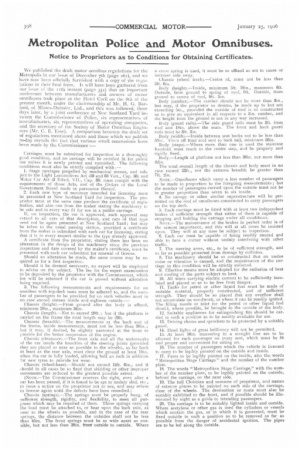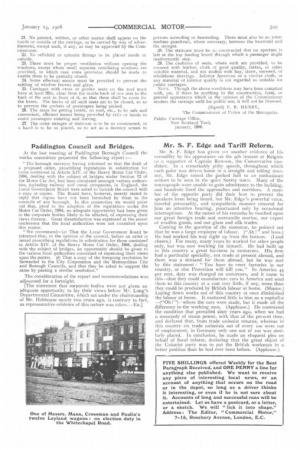Metropolitan Police and Motor Omnibuses.
Page 10

Page 11

If you've noticed an error in this article please click here to report it so we can fix it.
Notice to Proprietors as to Conditions for Obtaining Certificates.
We published the draft motor omnibus regulations for the Metropolis in our iStille Of Dee(Inther 7th (page 261), and we have now been officially furnished with a copy of the regulations in vheir final form. it will have been gathered front our issue of the ii al instant (page 351) that an important conference between manufacturers and owners of motor omnibuses took place at the Hotel Cecil on the 5th of the present month, under the cheirmanship of Mr. H. G. Burlord, of Miinee-Daimler, Ltd., and this was followed, three slays later, by a jeint conference at New Scotland Yard between the Commissioner of Police, six representatives of manufacturers, six representatives of operating companies, and the secretary of the Society of Motor Omnibus Engineers (Mr. C. E. Esse). A comparison between the draft set of regulations mentioned above and those which we publish to-day reveals the fact that various small concessions have been made by the Commissioner : Carriages must be submitted for inspection in a thoroughly good condition, and no carriage will be certified fit for public use unless it is newly painted and varnished. Tht following conditions must also he strictly complied with : 1. Stage carriages propelled by mechanical means, and subject to the Light Locomotives Art (59 and 60 Viet., Cap. 36) and Motor Car Act (3 Edwd. V11,, Cap. 361 must comply with the requirements of those Acts, and of the .Ordr.s of the Local Government Board made in pursuance thereof.
2. Each new type of motorcar intended for licensing must he presented at New Scotland Yard for inspection. The proprietor must at the same time produce the certificate of registration, and also one from the maker stating the machinery to be safe and in every way fit for use in a public carriage.
If, on inspection, the car is approved, such approval may extend to all cars of that description, and cars of that type need not be again presented at New Scotland Yard; but may he taken to the usual passing station, provided a certificate from the maker is submitted with each car for licensing, stating that it is in every respect similar to the type already approved. A certificate from the proprietor, stating there has been no alteration in the design of the machinery since the previous inspection and date covered by the maker's certificate, must be pyesented with each car submitted for renewal of license.
Should an alteration he made, the same course may be required as for a first inspection. Should it be deemed necessary, an expert will be employed to advise ori the subject. The fee for the expert examination to be deposited by the proprietor with the Commissioner, which fee will be returned if the car is passed without alteration being required. 3. The following measurements and requirements for an omnibus with top-deck seats must be adhered to, and the [limiter of passengers to be provided for on such vehicles must in no case exceed sixteen inside and eighteen outside : Chassis iheighte-From ground after the body is affixed, minimum 28in., maximum 34in.
Chassis (length).-Not to exceed 20ft.; but if the platform is carried on the frame the total length may be 23ft. Chassis (breadth).--The measurements at the back end of the frame, inside measurement, must not be less than 38in.; but it may, if desired, be slightly narrowed at the front to provide for the better suspension of the engine. Chassis (clearance) -The front axle and all the underworks of the car inside the knuckles of the steering joints (provided they are placed as near as possible to the wheels), as far back at least as the rear axle, must clear the ground at least 10in. when the car is fully loaded, allowing half an inch in addition for new tyres to provide for wear.
Chassis (wheel-base).--Should not exceed 14ft. fin., and it should in all cases be so fixed that skidding or other improper movements are reduced to the greatest possible extent.
(NOTE-The Commissioner reserves the right, even after a car has been passed, if it is fumed to be apt to unduly skid, etc., to issue a nctice on the proprietor not to use, and may refuse to license again until the defects have been remedied.) Chassis (springs).-The springs must he properly hung, of sufficient strength, rigidity, and flexibility, to meet all purposes which may be required of them. Those springs carrying the load must be attached to, or bear upon the back axle, as near to the wheels as possible, and in the case of the rear springs, the distance between the outsides shall not be less than 45in. The front springs must be as wide apart as possible, but not less than 38in. fttirir outside to outside. Where
doss spring is used, it must be so affixed as not to cause or increase side sway.
Chassis (wheel track).-Centre of, must not be less than Sit. 6iii.
Body (height),-Tneide, minimum 5ft. 10in., maximum 6ft. Outside, from ground to spring of roof, lift. Outside, from ground to centre of -_-oof, 9.tt.
Body (camber).-The camber should nut be more than Sin., but may, if the proprietor so desires, be made up to but not exceeding 5in., provided the outside of roof is so constructed as to give an equivalent in all respects to a 3m, camber, and the height from the ground is not in any way increased. Body (guard rails).-The side guard rails must be 31 t. from roof and 18in. above the seats. The front and back guard rails most be 31t. 3m.
Body {width).-Inside between seat backs not to be less than 56in. From off hind rout seat to back rail, minimum 26in.
Body (stepsl.-Where more than one is used the staircase handrail must reach to the centre step, and he properly and rigidly fixed. Burly-Length of platform not less than 36m. nor more than 42i a.
The total overall length of the chassis and body must in no case exceed 23ft., nor the extreme breadth be greater than 7ft. 2in, NOTE.-Orpnibuses which early a less number of passengers to he made in proportion to the foregoing measurements; but the number of passengers carried upon the outside must net be in greater proportion than seven to six inside. 4. No canopy or other similar superstructure will be permitted on the roof of omnibuses constructed to carry passeugers on the top deck. 5. Each carriage must be fitted with at least two independent brakes of sufficient strength that either of them is capable of stopping and holding the carriage under all conditions. NoTE.-The maintenance of the brakes in perfect order is of the utmost importance, and this will at all times be insisted upon. They will at any time be subject to inspection. 6. Each car must be capable of being readily steered and able to turn a corner without unduly interfering with other traffic.
7. The steering arms, etc., to be of sufficient strength, and as far as possible protected from damage by collision.
8. The machinery should he so constructed that no undue noise or vibration is caused, and the maintenance of the carriage in this condition will be strictly enforced. 9. Effective means must be adopted for the radiation of heat and cooling of the parts subject to heat. 10. All wires carrying electric current tn be sufficiently insulated and placed so as to be free from danger. 11. Tanks for petrol or other liquid fuel most be made of suitable material, properly constructed, and of sufficient strength. They shculd he so placed that any overflow shall not accumulate on wondwork, or where it can be readily ignited. The filling nozzle or inlet for the petrol or other liquid fuel should, where possible, be brought to the outside of the body. 12. Suitable appliances for extinguishing fire should be carried in such a position as to be readily available for use. 13. Driving chains and sprockets to be protected by a suitable guard. 14. Head lights of great brilliancy will not be permitted. 15. At 'east Thin, measuring in a straight line are to be allowed for each passenger on every seat, which must be fit and proper and convenient for sitting on. 16. The number of passengers which the vehicle is licensed to carry to he legibly painted on the outside and inside. 17. Fares to be legibly painted on the inside, also the words " Metropolitan Stage Carriage" and the number of the number plate.
1S. The words "Metropolitan Stage Carriage," with the number of the number plate, to be legibly painted on the outside, behind the carriage, on the near side.
19. The full Christian and surname of proprietor, and names of extreme places to be painted on each side of the carriage, clear of the 'wheels. The destination or route most also be suitably exhibited to flee front, and if possible should be illuminated by night as a guide to intending passengers. 20. The carriage is to be suitably lighted inside and outside. Where acetylene or other gas is used the cylinders or vessels which contain the gas, or in which it is generated, must be fixed outside in such a position as to be removed as far as possible from the danger of accidental ignition. The pipes are to be led along the outside. 21. No printed, written, or other matter. shall appear on the inside or outside of the carriage, or be carried by way of advertisement, except such, if any, as may be approved by the Corninissioner.
2:2. No celluloid or xylonite fittings to be placed inside or outside.
23. There must be proper ventilation without opening the windows, except where small separate ventilating windows are provided, in which case some provision should be made to enable them to be partially closed. 24. Some effectual means must be provided to prevent the rattling of window frames and glass.
25. Carriages with cross or garden seats on the roof must have at least 26in. clear from the inside back of one seat to the back of the seat in front of it, so that there shall be room for the knees. The backs of all such seats are to be closed, so as to prevent the pockets of passengers being picked.
26. The steps for getting inside, on roof, etc., to be safe and convenient, efficient means being provided by rails or bands to assist passengers entering and leaving.
27. The outer stringer of staircase is to be so constructed, or a band is to be so placed, as to act as a decency screen to
persons ascending or descending. There must also be au intermediate guard-rail, where necessary, between the hand-rail and the stringer. 28. The staircase must be so constructed that no aperture is left at the top landing board through which a passenger might inadvertently step. 29. The cushions of seats, where such are provided, to be covered with leather, cloth of good quality, rattan, or other suitable material, and not stuffed with hay, straw, seaweed, or whalebone shavings. Inferior American or a similar cloth, or any material of inferior quality is not regarded as suitable for public carriages. NOTE. Though the above conditions may have been complied with, yet, if there be anything in the construction, form, or general appearance which in the opinion of the Commissioner renders the carriage unfit 'for public use, it will not be licensed.
(Signed) F.. R. HENRY, The Commissioner of Police of the Metropolis.
Public Carriage Office, New Scotland Yard, January, 1906.
















